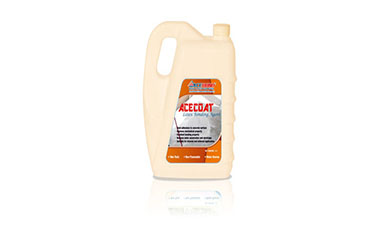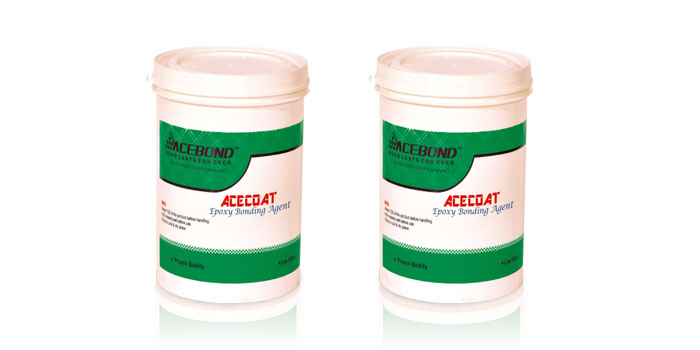
Products
Acecoat-Epoxy Primer cum Bonding agent
Description
ACECOTE Epoxy bonding agent is a 100% solid, moisture-tolerant epoxy system designed to increase the bond between freshly-placed repair mortars or concrete mixes and existing concrete. It consists of pre-weighed Part A and Part B in pail. It is a high abrasion and impact resistant coat and has very good adhesion to concrete surface, plaster and all kind of metal.
- For interior and exterior application
- Bonds to both damp and dry concrete
- 25-minute pot life at 75°F (24°C)
- 3-hour open time at 75°F (24°C) for repair mortar installation
- Can be applied by brush, roller, spray or squeegee
- Used for expansion and repair of structural concrete
- Bonding agent for steel and structural membrane
Uses:
- Bonding new concrete or repair mortars to existing concrete
Mixing:
Mixing: Pour Hardener into Resin and add required amount of Portland cement, if necessary. Proportion Component “Resin” and Component “Hardener” at a 1Hardener:2Resin ratio by volume in a clean pail and add approximately 1 kg cement to 10 kg mix (if necessary). Mix thoroughly with a low-speed (300–600 rpm) drill and mixing paddle for 3 minutes, scraping unmixed material from sides and bottom of mixing container as needed. Avoid entrapping air into mixture. Do not prepare more material than can be used within the pot life of the product.
Remove all standing water by vacuum or blowing with oil-free, compressed air prior to installation. Acecoat Epoxy Bonding Agent can be installed on damp or dry surfaces. Do not install through standing water. Avoid installing at high temperatures or windy conditions to maximize open time. Never apply in direct sunlight. Apply Acecoat Epoxy Bonding Agent by brush, roller, spray or squeegee. Immediately install repair materials or concrete mix into wet Acecoat Epoxy Bonding Agent. Do not allow Epoxy Bonding Agent to dry or become tack-free before concrete or mortar installation. If Epoxy Bonding Agent does dry or becomes tack-free, abrade surface and recoat. Do not apply more bonding agent than can be effectively covered with repair mortars or concrete mixes while remaining wet.
Surface preparation
Concrete surface must be sound, clean and free of all contaminants that could impair product adhesion, bond or performance. Concrete should be a minimum of 28 days old or substantially cured to the equivalent design strength prior to installation. Remove all loose or deteriorated concrete by chipping hammer, water jetting, or other mechanical means to achieve an open pore structure and sound concrete surface. Remove all cleaning media and debris by vacuum or blowing with high-pressure, oil-free air.
For METAL SURFACES: Use a wire brush or sandpaper to remover rust and scale from the surface to be protected. Surfaces may be shot blasted or abraded using a wire wheel for best results. All dirt, grease, and old paint should be removed. All clean dry surfaces is essential for the best results. Begin with a sound, clean, dry and roughened, oil-free application surface
For NEW POURED CONCRETE: Allow to fully cure (28 days @ 70°F) prior to application. Remove any curing membrane by sanding or etching with a strong detergent.
For OLD CONCRETE: Thoroughly clean surface with a grease-cutting detergent to remove grease and oils, and remove any loose or unsound concrete by chipping, scarifying, shotblasting, sanding, or grinding. Proceed as for new poured concrete.
For PREVIOUSLY COATED CONCRETE: Remove any peeling or degraded paint by sanding or using a paint stripper. For intact paint, thoroughly clean the surface with a strong detergent, then lightly sand to remove any gloss. Treat any areas worn down to the original concrete as bare concrete.
Pack size:
Available in 1 kg and 10kg (Including 2 components). Each kits consists of carefully prepared, superior quality Resin and Hardener
Shelf life:
12 months, if stored in cool and dry area in unopened containers, protected from sun light. Shelf life is calculated from the month of manufacturing of the product.
LIMITATIONS
- It is not recommended to use on surface where continuous temperature exposure above 100°C.
- Epoxy, epoxy residue, or wash water will discolour painted or anodized surfaces upon contact. Should be tested for possible staining or slight colour changes when used with porous, absorptive, textured surface.
- Lower temperatures will cause the epoxy to become stiff and more difficult to work and will extend initial set. Higher temperatures will cause the epoxy to become more fluid and will accelerate the set.
- Not recommended in some manufacturing facilities where heavy chemicals are used. Consult Technical Services on questionable installations.
- Colours may be slightly different than shown. When colour considerations are critical, a mock-up should be constructed prior to final application.
PROTECTIVE MEASURES:
The use of safety glasses and chemically resistant gloves is recommended. Use appropriate clothing to minimize skin contact. The use of a NIOSH-approved respirator is required to protect respiratory tract when ventilation is not adequate to limit exposure below the PEL. Refer to Material Safety Data Sheet (MSDS) available at msds for detailed information.
Related Products


